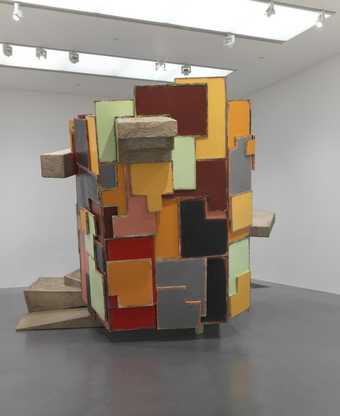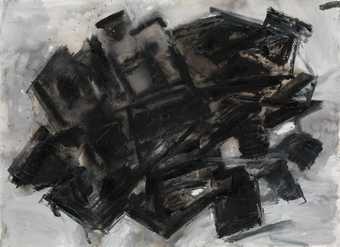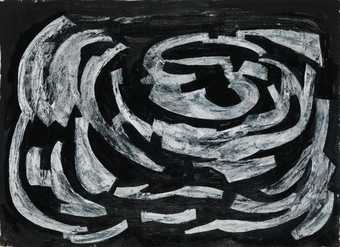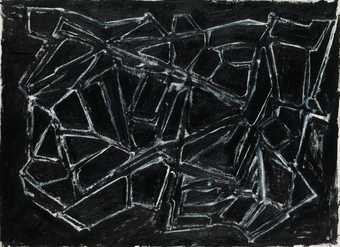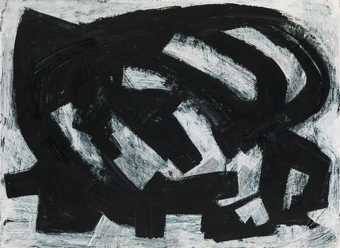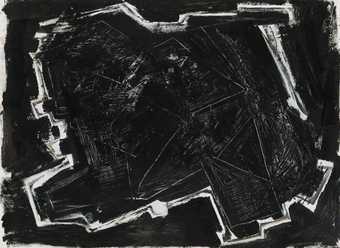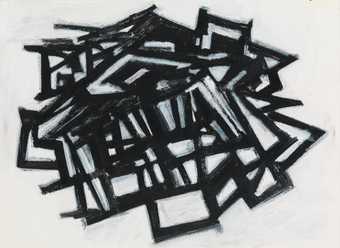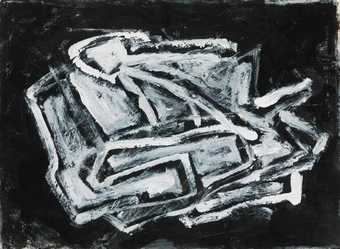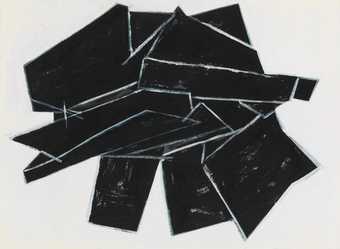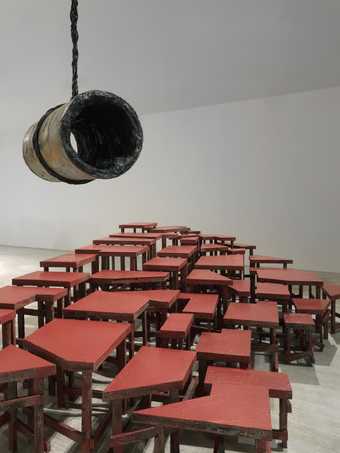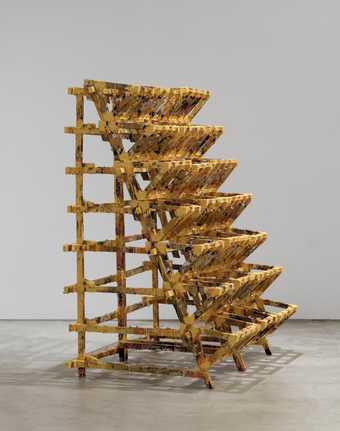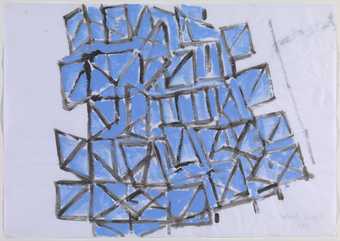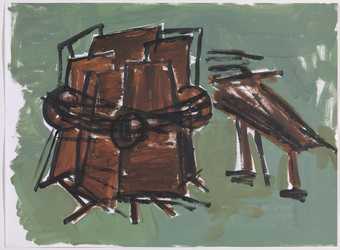Not on display
- Artist
- Dame Phyllida Barlow DBE RA 1944 – 2023
- Medium
- Steel, plywood, polystyrene, felt, cement, paint, tarpaulin and fabric
- Dimensions
- Object: 2616 × 6071 × 2311 mm
- Collection
- ARTIST ROOMS
Tate and National Galleries of Scotland. Lent by Artist Rooms Foundation 2017
On long term loan - Reference
- AL00396
Summary
untitled: awnings, 2012 2012 comprises a series of seven wedge-shaped sculptural forms, jutting out from the wall above head height in a densely packed row. The upper face of each is flat and slopes down from the wall, and the underside is open, resembling a canopy or awning, which appears to have been made from roughly hewn concrete slabs. Each form has been created with a steel frame and polystyrene sheet, over which polyurethane foam, cement scrim and sand have been applied, and then varnished.
These grey, visor-like roofs are draped festively in layers of lightweight fabric of different colours and sizes, loose threads hanging from frayed edges, and invite viewers to duck beneath their partial protection. The coloured rectangles of reds, pinks, oranges and yellows are characteristic of Barlow’s distinctive palette and introduce a playful atmosphere, as well as a sense of theatre or staging. The ambiguities of what an object is made of, appearance versus reality, heavy versus light, hollow versus solid, permanence and fluidity, are all part of the process of encountering the object through ‘the complicated act of looking’ that Barlow wishes to orchestrate, to encourage the viewer to actively explore the work, moving around it to discover its inherent paradox and duality (quoted in Phyllida Barlow: folly 2017, p. 11). Her installations actively engage viewers by drawing them among, under or around obstacles in much the same way that we navigate our environment on a daily basis.
Barlow’s practice is focused on materials and the act of making: her work explicitly engages with process. Expediency and availability drove Barlow’s early choice of everyday materials for her work, drawing her inspiration from the urban environment and the streets near her home. Having rejected the predominant sculptural aesthetic of the British sculpture scene of the 1960s, dominated by the production of cast and welded sculptures, Barlow embraced the new environmental sculpture, making temporary structures from discarded building materials and siting them in warehouse and parks. Necessity drove her to develop a practice of making-do, scavenging material, and much of what she produces in her installations is recycled and repurposed into her next projects; a process of production, deconstruction and reconstruction, encapsulating entropy and fragility, that mirrors the life-cycles of the natural world.
It is typical of the artist’s practice that she revisits ideas, more or less closely, and this is the case with untitled: awnings, 2012. It was first shown in the exhibition …..later in 2012, her first exhibition at Hauser & Wirth, New York, which also included the sculpture untitled: upturnedhouse 2012 (see also untitled: upturnedhouse, 2 2012 [Tate AR01228]). The sculptural form of awnings reappears in a larger version in eleven parts, which was included in the artist’s solo show Phyllida Barlow: scree, at Des Moines Art Center, Des Moines in 2013, where it shared the exhibition space with the monumental untitled:screestage 2013, later presented as part of the Hepworth Prize in Wakefield in 2016. Barlow re-explored the ‘awning’ in untitled: folly; awnings; 2016/2017 2016–17, part of her installation, entitled folly, commissioned for the British Pavilion at the 57th International Art Exhibition in Venice in 2017.
Many of Barlow’s installations include such recognisable objects as awnings, columns, axles and placards, which she collectively refers to as ‘substitutions’ or ‘surrogates’. Some of these approximations resemble their referent, others barely hint at any relation to an actual object. Barlow’s interplay between abstract and the apparently representational is a deliberate part of her exploration of the nature of sculpture and its relation to the real and its counterpoints. The overt artificiality of these sculptural surrogates, with their roughly hewn and ambiguous forms, evades description, and keeping this ambiguity open allows the viewer to question the nature of the encountered object. The artist has explained, ‘They are almost props – they have that theatrical association, they are aspiring to be but they aren’t – so in a way they are frail symbols of something.’ (Quoted in Barlow 2017, p.10). Barlow’s sculpture subverts the easily encapsulated; the interplay of real and fake, the tension of form and formlessness, the duality of front and back, theatricality, and the role of colour and paint in sculpture are abiding concerns of her practice. In her own words, her sculpture is ‘wordless, wild, messy, unpredictable, ugly, difficult’ (quoted in Barlow 2004, p. 63).
Further reading
Phyllida Barlow, Objects For … And Other Things; Phyllida Barlow, London 2004.
Fiona Bradley (ed.), Phyllida Barlow, Sculpture 1963–2015, exhibition catalogue, Fruitmarket Gallery, Edinburgh 2015.
Phyllida Barlow: folly, exhibition catalogue, 57th International Art Exhibition – La Biennale di Venezia, Venice 2017.
Ceri Lewis
September 2017
Does this text contain inaccurate information or language that you feel we should improve or change? We would like to hear from you.
You might like
-
Dame Phyllida Barlow DBE RA untitled: upturnedhouse2, 2012
2012 -
Dame Phyllida Barlow DBE RA untitled: torque, 2015
2015 -
Dame Phyllida Barlow DBE RA untitled: black 1, 2014
2014 -
Dame Phyllida Barlow DBE RA untitled: black 2, 2014/2015
2014–5 -
Dame Phyllida Barlow DBE RA untitled: black 3, 2014
2014 -
Dame Phyllida Barlow DBE RA untitled: black 4, 2014
2014 -
Dame Phyllida Barlow DBE RA untitled: black 7, 2015
2015 -
Dame Phyllida Barlow DBE RA untitled: black 9, 2015
2015 -
Dame Phyllida Barlow DBE RA untitled: black 10, 2015
2015 -
Dame Phyllida Barlow DBE RA untitled: black 11, 2014
2014 -
Dame Phyllida Barlow DBE RA untitled: brokenstage/hangingcontainer, 2012/2013
2012–3 -
Dame Phyllida Barlow DBE RA Untitled (Yellow Rack)
2006 -
Dame Phyllida Barlow DBE RA Untitled
1997 -
Dame Phyllida Barlow DBE RA Untitled
1999 -
Dame Phyllida Barlow DBE RA Untitled
2003


